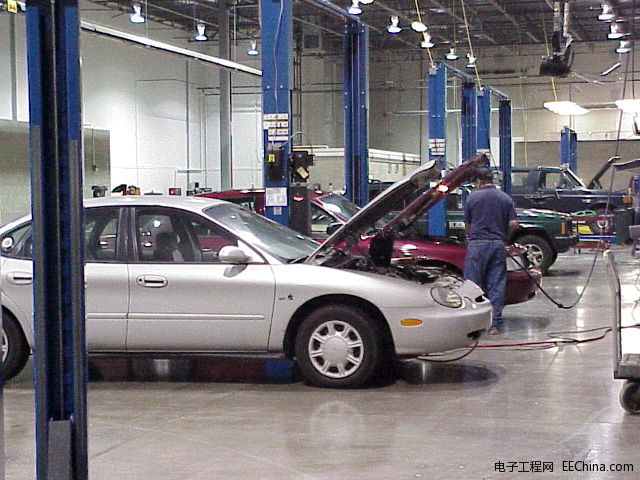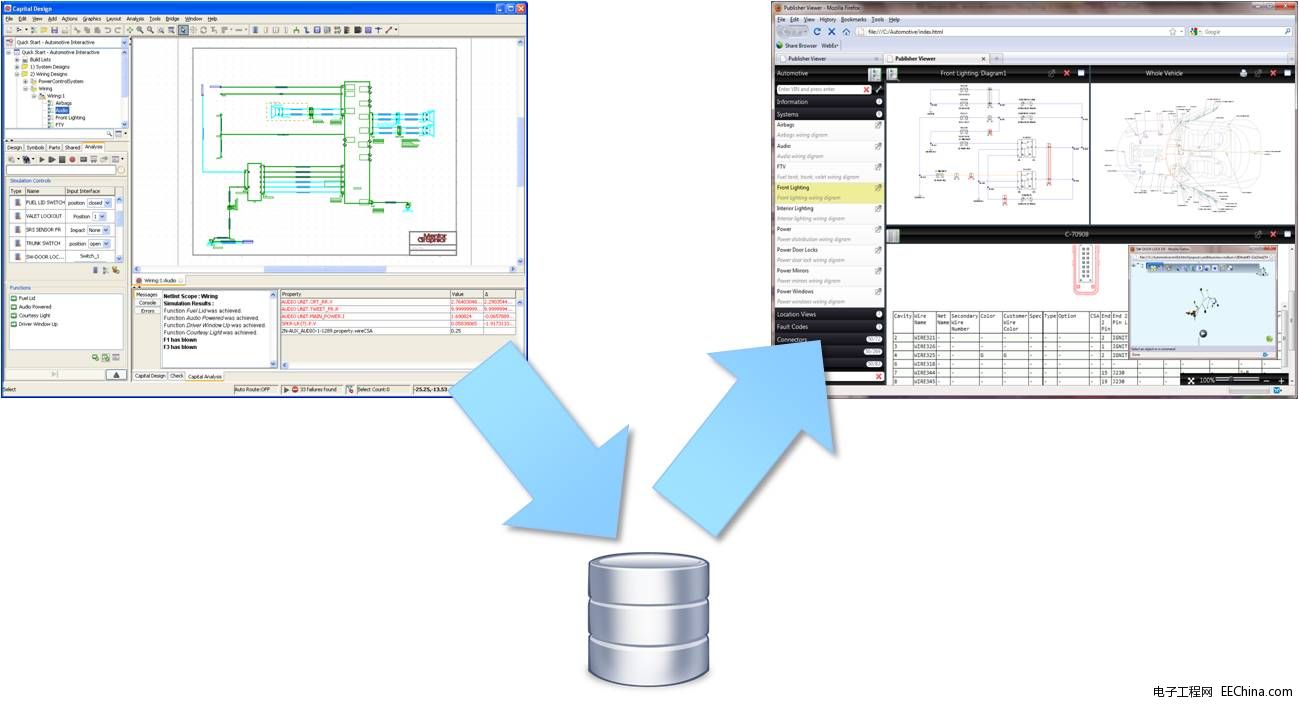
This article refers to the address: http://
Compared to the development of new systems such as smart roads and driverless cars, the design of document production and the overhaul of car faults seem tedious. But in fact, document production is a time-consuming, costly, and error-prone work; speeding up troubleshooting can save costs and improve the brand's image in the end customer's mind, and can also reduce the repair time of commercial vehicles. Therefore, economically, these tedious jobs can actually have a very important impact. This paper specifically analyzes the new document making and troubleshooting process improvement techniques for vehicle electrical systems.
So, where is the problem? We all recognize that in the past ten or twenty years, the vehicle electrical system has become very complicated due to the large increase in the number of installed electronic components such as embedded software. The vehicle electrical system is responsible for the power and signal distribution of the vehicle, and its function is very similar to that of the human body's central nervous system. As the number of electronic systems installed increases, so does the number of signals, and the nervous system becomes more complex. According to the requirements of the regulatory authorities, this nervous system must be accurately documented, usually through schematics, wiring diagrams and positional views. Creating a complete document is a critical step in delivering a new car.
It is not impossible to add document handlers while adding components to the electrical system. But the problem is actually more complicated than it seems, for two reasons. First, the rate of change in the electrical system is very high in improving the design, adding new features, and upgrading parts. Second, the multiple configuration options available to the general public result in a wide variety of electrical system configurations, and each of these electrical configurations must be documented.
If you don't have important automation features, the cost of creating and maintaining a suitable document can be very high or not at all. This in turn raises a series of legal risks, for example, because the vehicle has a wrong service due to the expiration of the document, what should happen if an accident occurs?
But the task is much more than just dealing with the problem of document production. Unfortunately, automotive electrical systems can be very unreliable, with fuses being blown, terminals being corroded, and grounding bolts failing. Although the fault diagnosis system is still improving, in a large number of cases, the fault is still determined by the technician after reading the document. Given the high system complexity and even higher configuration complexity, unfortunate technicians will need some help.

Figure 1: Higher electrical complexity makes it difficult to find and fix faults.
And there is still a business problem. Usually, the service organization is a franchise. Rapid troubleshooting is important for profitability, so they put pressure on automotive OEMs to provide an efficient environment for technicians. Perhaps more important is the experience brought to the end customer. It is possible to return to the repair shop in addition to failing to solve the problem due to the initial repairs, and there is little more disheartening than waiting for the vehicle to be repaired for a long time. This in turn will have an impact on the brand image, which is a vital element of competition in the market. For operating vehicles such as heavy trucks, trucks and taxis, excessive repair time can have a direct impact on their income.
Given the importance of making accurate documentation and fast troubleshooting, it's strange to use almost no technology. Although the process is somewhat different, it is not uncommon to re-manufacture electrical system documentation based on design data and all of the cost, accuracy, and time issues encountered. Automation is often limited to drawing aids and content management systems. As for capturing manufacturing angles rather than design angle data, don't count on it!
Equally bad, the environment of service technicians is often more important than electrical documentation (sometimes even real paper documents). Documents are static, difficult to navigate, and not specific to configuration. It is not surprising that the discovery and repair of faults does not always follow the plan.
Document production and delivery as well as maintenance technicians end users need better technology. Fortunately, this can now be achieved, not only through one-time custom development, but also through standardized commercial software that can be configured and placed in a larger environment.
Start with the creation and distribution of documents. The focus is on the direct reuse of refined and modified engineering design data to understand the actual vehicle-building situation. If the design process itself is well controlled, automatically reusing the design data can easily solve the problems of change management, accuracy and timeliness, so that accurate data can speed up document production. Creating accurate electrical design information is relatively straightforward, and you can use software tools that focus on data rather than drawings because they have powerful features such as validation and consistency checking.
However, the automatic reuse of such design (or manufacturing) data requires a small amount of technology during document production and troubleshooting. The most important thing is to capture all-round design data with a pattern that collects all the data you need. A sophisticated data model can automate many useful operations, such as automatically generating auxiliary files such as device lists and routing sheets. In addition, the data model can be automatically repartitioned, and complex off-page cross-references may no longer be required. For example, the background link of the neighborhood data: the object matching technology can use the relevant information to create a diagnostic program, a 3D model, a location map, a link to a fuse box map, and the like. As can be seen from the above three examples, not only does the time required to create a document be greatly shortened, but the quality is also improved by minimizing human intervention.
Reuse of data can also solve configuration problems. If the electrical data model captures the option configuration, it can be connected to the vehicle configuration database (usually based on the vehicle identification code), button generation configuration, and even document production for a particular vehicle.
Finally, some tasks also need to be applied to techniques that automatically convert graphical content, such as chart composition, re-layout, symbol replacement, language switching, and change storage. Using these technologies at the same time can greatly speed up the creation of specific vehicle documents, ensuring the accuracy and validity of the documents while complying with regulatory and practical requirements.

Figure 2: Multi-domain design data can be automatically reused for document production and services
Of course, creating a document doesn't mean everything is going well. The next step is to distribute it to authorized recipients quickly and securely. We are in a world where security policy, access control and system performance cannot be ignored. Often electrical documentation will be part of a larger environment. This environment is mission-critical and is normally provided and managed by large IT vendors. It is therefore important that the documentation process be flexible enough to automatically generate any required electronic format so that it can be integrated into the overall environment. The most important thing is to consider IT costs from the perspective of the end user. This is because the maintenance organization is decentralized under natural conditions, and it is best not to use IT to minimize the use of IT. No special software should be installed on site, and for legal, commercial, and practical reasons, it is not realistic for documentation vendors to expect end users to be granted separate licenses.
Our T-Bulb Light is made of pure PC material with two connectors B22&E27. T-bulbs use non-isolated driver and the voltage is 170-300V. The T-shaped shell and turnable axis are the unique features of T-bulbs. It has 10 watt power and its CRI is more 80, luminous efficiency is 80LM/W. The color temperatures include cool white, warm white and natural white. This type of bulbs light is in elegant shape, easy installation and good quality. These T-bulb lamps have a two-year warranty, mainly used in office, bedroom, supermarket and so on.
Type T Bulb Led,T Led Bulb Price,T Bulb,Type T Light Bulb Led
Jiangmen Lika Lighting Electrical Appliances Co., Ltd , https://www.lika-led.com